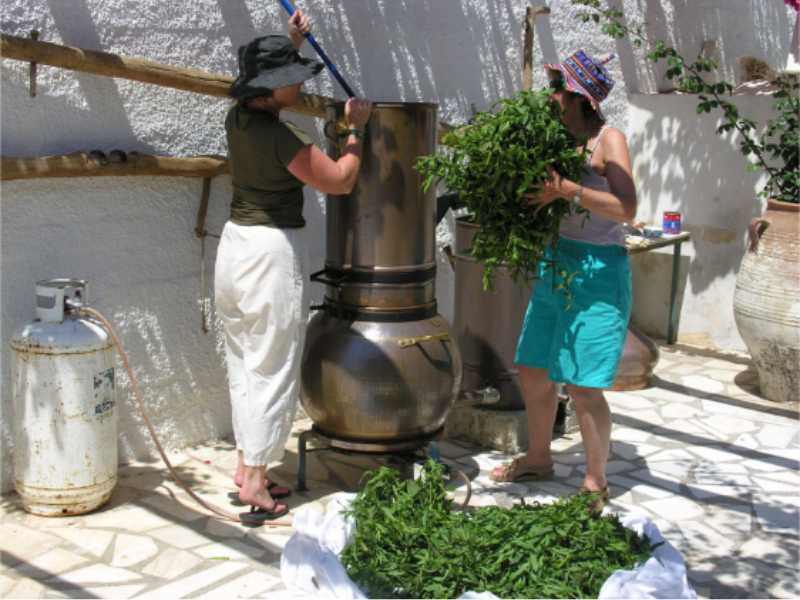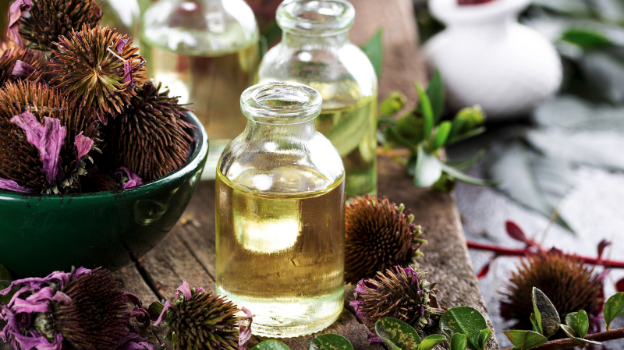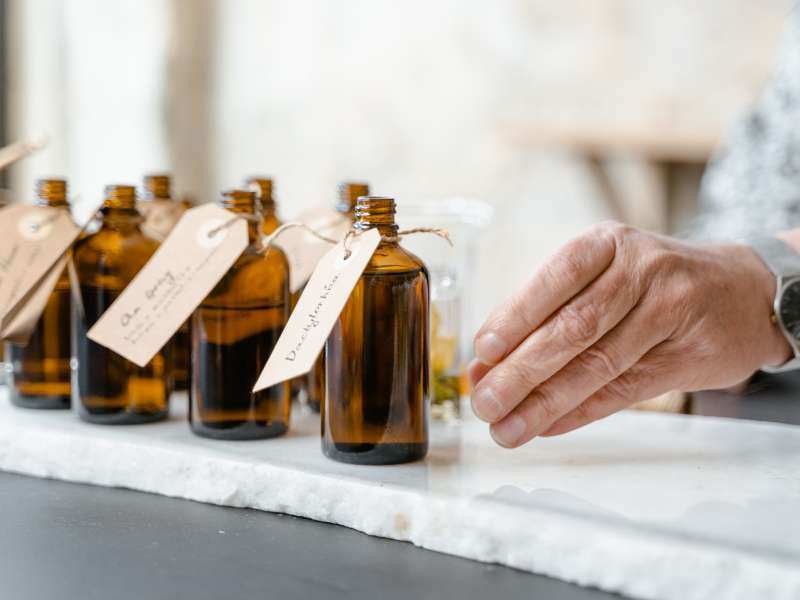Reviewed by ACHS Founding President Dorene Petersen and Master Distiller Robert Seidel
Essential oils have been cherished for centuries for their therapeutic properties and aromatic qualities. The journey from plant to bottle is intricate, involving various steps that ensure the highest quality and efficacy. We will explore the essential oil production process, focusing on the importance of plant quality, distillation methods, and the different types of distillation.
Quality of the Plant
 The foundation of any high-quality essential oil is the plant itself. The plant's health, growth conditions, and harvesting methods significantly impact the oil's final quality.
The foundation of any high-quality essential oil is the plant itself. The plant's health, growth conditions, and harvesting methods significantly impact the oil's final quality.
What is considered “high-quality” plant material? Here are 6 main factors:
-
Organic farming:
It is always best when possible as it can increase the soil quality and it avoids the use of synthetic pesticides and fertilizers, which can contaminate the oils1. -
Proper growth conditions:
The environment in which the plants are grown greatly impacts their quality. Factors such as soil type, climate, altitude, and water quality must be optimal for the specific plant species. High-quality plants are typically grown in their native regions, where they naturally thrive. High-quality plant material must be free from diseases and pests. -
Disease-free plants:
Plant diseases can alter the plant's chemical composition, resulting in lower-quality essential oils. The quality of the plant material is key to the quality of the essential oil. When plants are affected by diseases or pests, their chemical makeup can change, which often results in essential oils that are less effective and have a different aroma. Healthy plants yield the most beneficial and potent oils2,3. -
Harvesting the correct part of the plants and at the right time:
The harvest timing is crucial for obtaining high-quality essential oils. In general, focus on distilling only the parts of the plant that contain essential oils. For example, in some cases, you might need to distill the entire stem, leaf, and flower, while in others, it's just the root, flower, or bark. Harvesting at the right time is also crucial for maximizing oil yield. For example, lavender should be harvested when flowering and vetiver root 15-18 months after sowing4. Understanding the individual plants' harvest time is crucial.
-
Proper handling and storage:
After harvesting, plants should be handled and stored properly to maintain their quality. This includes avoiding excessive exposure to heat, light, and air, which can degrade the essential oils in the plant material. Plants should be distilled as soon as possible after harvesting to prevent the loss of volatile compounds5. If the plant material needs to be dried before distillation, it should be done in a manner that preserves the essential oils. This typically means drying in a dark, well-ventilated space at low temperatures to prevent the loss or alteration of the volatile compounds. -
Specific plant varieties:
Certain plant varieties are known to produce higher-quality essential oils showing different levels of constituents in each chemotype. Selecting the right variety or chemotype of a plant can significantly affect the quality and characteristics of the oil. It is important to first understand the different varieties of the plant that can be grown and how they are best used. For instance, different chemotypes of thyme Thymus vulgaris produce oils with different constituents, therefore varying therapeutic properties.
Quality of the Distillation
 The distillation process is pivotal in preserving the plant's therapeutic properties. Quality distillation involves precise control over temperature, pressure, and time. The art of distillation is a science and also comes with experience. Experts in this field are called Master Distillers. It takes years of passion and dedication to learn this craft.
The distillation process is pivotal in preserving the plant's therapeutic properties. Quality distillation involves precise control over temperature, pressure, and time. The art of distillation is a science and also comes with experience. Experts in this field are called Master Distillers. It takes years of passion and dedication to learn this craft.
Different Types of Distillation
Steam Distillation
Steam distillation is the most common method for extracting essential oils. It involves passing steam through the plant material, which vaporizes the volatile compounds. These vapors are then condensed back into liquid form and collected.
Examples of steam-distilled oils:
- Lavender Oil Lavendula officinalis
- Peppermint Oil Mentha piperita
- Eucalyptus Oil Eucalyptus globulus
- Rosemary Oil Rosmarinus officinalis
Steam Distillation image showing how the water flows through the plant material and separates the essential oil. Please note: While most essential oils float to the top of the separator, when distilling a “heavy” oil such as nutmeg the essential oil will instead sink to the bottom.
Hydro Distillation
In hydro distillation, plant materials are immersed in water, and the mixture is heated to produce steam. This method is often used for delicate flowers that might be damaged by direct steam.
Examples of hydro-distilled oils:
- Rose Oil Rose damascena
- Neroli Oil Citrus bigaradia
Cold Press Extraction
Cold press extraction, also known as expression, is primarily used for citrus oils. The process involves mechanically pressing the oil from the plant material, usually the peels of citrus fruits. This method preserves the oils' delicate aromatic properties.
Examples of cold-pressed oils:
- Sweet Orange Oil Citrus sinesis
- Lime Oil Citrus aurantifolia
- Grapefruit Oil Citrus paradisi
Solvent Extraction
Solvent extraction is used for certain plants that do not yield oil easily through steam distillation. This method involves using a solvent to dissolve the essential oils from the plant material. The solvent is then removed, leaving behind a concentrated oil known as an absolute. While effective, this method can sometimes leave trace amounts of solvent in the final product. Due to this possibility, some aromatherapists prefer to use absolutes sparingly7.
Examples of solvent-extracted oils:
- Jasmine Absolute Jasminum sambac
- Benzoin Resinoid Styrax tonkinensis
CO2 Extraction
CO2 extraction is a method for obtaining essential oils that involves the use of carbon dioxide. Under very high pressure, carbon dioxide becomes a liquid that can effectively act as a solvent to extract essential oils from plant material. Once the pressure is reduced, the liquid carbon dioxide evaporates back into a gas, leaving no residue of the solvent behind. This process is noted for its purity because it avoids residual solvents and uses low temperatures, which helps preserve the delicate compounds of the essential oils. Although CO2 extraction requires specialized technology and is more costly due to the high pressure needed, it is valued for producing oils that are considered the "truest to nature" in their chemical composition and aromatic profile7.
Examples of CO2-extracted oils:
- Turmeric Oil Curcuma longa
- Coffee Oil Coffea Arabica
Explore the World of Aromatherapy
Are you fascinated by the world of essential oils and aromatherapy? Enhance your knowledge and skills with an accredited online degree in aromatherapy. The American College of Healthcare Sciences (ACHS) offers comprehensive programs that explore the science and art of aromatherapy. Learn more about our accredited online aromatherapy degrees and take your passion to the next level!

Sources:
1. Cáceres, Daniel M. “(PDF) Organic farming and the sustainability of agricultural systems.” ResearchGate, https://www.researchgate.net/publication/222545656_Organic_farming_and_the_sustainability_of_agricultural_systems
2. Boutekedjiret, C., Bentahar, F., Belabbes, R., & Bessiere, J. M. (2003). Extraction of rosemary essential oil by steam distillation and hydrodistillation. Flavour and Fragrance Journal from https://onlinelibrary.wiley.com/doi/epdf/10.1002/ffj.1875
- Molina, J., Vanneste, S., & Kyndt, T. (2021). Plant secondary metabolites: Synthesis and roles in plant–herbivore interactions. Frontiers in Plant Science, 12, 623529. https://www.ncbi.nlm.nih.gov/pmc/articles/PMC8910576/
- Kumar, S., & Singh, R. (2005). Vetiver oil: An essential oil from aromatic roots. National Horticulture Board. https://nhb.gov.in/bulletin_files/aromatic/vetiver/vet003.pdf
- Chemat, F., Vian, M. A., & Cravotto, G. (2017). Green extraction of natural products: concept and principles. International Journal of Molecular Sciences, 13(7), 8615-8627. https://doi.org/10.3390/ijms13078615
- Hussain, A. I., Anwar, F., Nigam, P. S., Ashraf, M., & Gilani, A. H. (2010). Seasonal variation in content, chemical composition and antimicrobial and cytotoxic activities of essential oils from four Mentha species. Journal of the Science of Food and Agriculture, 90(11), 1827-1836. https://www.ncbi.nlm.nih.gov/pmc/articles/PMC5302419/
- American College of Healthcare Sciences. 2024. Aroma 101: The basics of essential oils and aromatherapy. ACHS Press.





